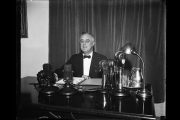From the very start of President Franklin Delano Roosevelt’s administration, there were unmistakable indications that his “New Deal” would be moving in the statist direction. Frances Perkins, FDR’s secretary of labor, recounted, decades later, a telling occurrence at the first FDR Cabinet meeting. She recalled:
At the first meeting of the Cabinet after the President took office in 1933, the financier and adviser to Roosevelt, Bernard Baruch, and Baruch’s friend General Hugh Johnson, who was to become the head of the National Recovery Administration, came in with a copy of a book by Gentile, the Italian Fascist theoretician, for each member of the Cabinet, and we all read it with great care.
Perkins related the Cabinet story to George Rawick, a socialist historian and professor, who published the quote above in an essay he wrote in 1969 for Radical America, the journal of the Students for a Democratic Society (SDS).
The “Brain Trust” that was guiding FDR’s new experiment in governance was composed of collectivists of various ideologies — fascist, socialist, and communist — who were all afire with zeal to “transform” and “restructure” America. Collectivism was in the air; the intellectuals and political classes were enthralled with the supposed wonders of central planning that were being reported in Italy under the fascist system of Benito Mussolini (Il Duce, “The Leader”) and in Soviet Russia under the Communist Party leadership of Josef Stalin. “Scientific” control and management of all aspects of society by “highly qualified” administrators was all the rage.
Even Adolf Hitler, who had just been installed as Chancellor of Germany a month before Roosevelt’s inauguration, was in vogue with many “liberals” and “progressives.”
Harold Ickes, FDR’s secretary of the interior, admitted years later that “what we were doing in this country were some of the things that were being done in Russia and even some of the things that were being done in Germany. But we were doing them in an orderly way.” Roosevelt himself extolled Mussolini as “that admirable Italian gentleman” and told U.S. Ambassador to Italy Breckenridge Long, “I am much interested and deeply impressed by what he has accomplished and by his evidenced honest purpose of restoring Italy.”
According to the New York Times, the general feeling among the ruling class in Washington, D.C., at the outset of the new FDR administration was that America needed a strong autocrat (some even called for a dictator) to deal with the economic crisis. The atmosphere in our nation’s capital was “strangely reminiscent of Rome in the first weeks after the march of the Blackshirts, of Moscow at the beginning of the Five-Year Plan,” the Times reported on May 7, 1933. “America today literally asks for orders,” the article averred. And the new administration is responding, reported the Times, with a plan that “envisages a federation of industry, labor and government after the fashion of the corporative State as it exists in Italy.”
“If this country ever needed a Mussolini, it needs one now,” said Senator David Reed, a Pennsylvania Republican. Walter Lippmann, the “dean of American journalists,” opined that “‘dictatorial powers,’ if that is the name for it — is essential.”
Mussolini summed up his political philosophy in this motto: “All within the state, nothing outside the state, nothing against the state.” Roosevelt magnanimously agreed to follow Il Duce’s example — if necessary for the good of the country. In his Inaugural Address, he said he would work with Congress to tackle the crisis. But if that proved insufficient, he would seek “temporary departure,” requesting “broad Executive power to wage a war against the emergency, as great as the power that would be given to me if we were in fact invaded by a foreign foe.”
If the New Deal failed to reach the totalitarian heights (or depths) of Mussolini’s “total state,” it was not for lack of trying. Team FDR took full advantage of the presidential honeymoon and the bipartisan atmosphere to make the first 100 days of the New Deal a transformative epoch. A compliant Congress rushed through a torrent of “emergency” legislation creating a vast new sea of programs and an alphabet soup of new regulatory agencies: AAA, NRA, CCC, FCC, TVA, SEC, FHA, WPA, NYA, etc.
Unconstitutional Fourth Branch
The regulatory agencies that mushroomed during the New Deal have continued to proliferate and now write more of our “laws” than does our elected Congress. (See the related article “Danger: Federal ‘Regulatory Cliff’ Ahead.”)
Roosevelt appointed James Landis, who was dean of the Harvard Law School, to the Federal Trade Commission and the Securities and Exchange Commission. Landis’ chief influence, though, may have been through his 1938 Yale Law School lectures, published as The Administrative Process, in which he openly declaims against the constitutional separation of powers. According to Landis’ The Administrative Process, agencies in the modern state need to have “not merely legislative power or simply executive power, but whatever power might be required to achieve the desired results.”
“By Firing Squad if Necessary”
There were many other similarly inclined apostles of absolutism running rampant in the New Deal regime. In our limited space here, we focus on two who were particularly noteworthy in advancing the destructive processes of the administrative state:
• Stuart Chase: A product of MIT and Harvard, Chase is best known for his 1932 book, A New Deal, the title and substance of which were adopted as the program of the Roosevelt administration. In that book, Chase argued for elimination of our free enterprise system “by firing squad if necessary.” He hoped the “whole vicious pecuniary complex would collapse as it has in Russia.”
A member of the Fabian Socialist Society, Chase toured Stalin’s Soviet Union in 1927, meeting with and interviewing Stalin and Trotsky. He described the Soviet Five Year Plan as a “courageous and unprecedented experiment.” He concluded his New Deal book by asking: “Why should the Russians have all the fun of remaking the world?”
• Rexford Guy Tugwell: An economics professor and Fabian Socialist, Tugwell toured the Soviet Union with Stuart Chase — and returned to rhapsodize about the glories of socialism in the new workers’ paradise.
In an address to the American Economic Association in December 1931 Tugwell approvingly invoked Stalin’s Russia as a vision for America’s future. “There is no denying,” he proclaimed, “that the contemporary situation in the United States has explosive possibilities. The future is becoming visible in Russia.” Moreover, he remarked:
The first series of changes will have to do with statutes, with constitutions, and with government…. It will require the laying of rough, unholy hands on many a sacred precedent, doubtless calling for an enlarged and nationalized police power for enforcement…. Planning will necessarily become a function of the federal government; either that or the planning agency will supersede that government…. It has already been suggested that business will logically be required to disappear. This is not an overstatement for the sake of emphasis; it is literally meant.
“FDR fundamentally expanded the reach and power of the federal government, which most Americans now accept, especially in times of crisis,” remarked U.S. News & World Report in 2009. “And that marked a monumental change in American life”
Photo of FDR: AP Images
Related articles:




